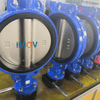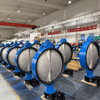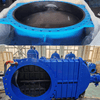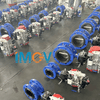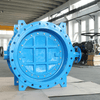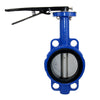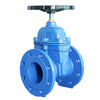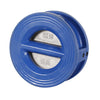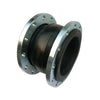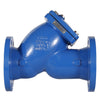How to Accurately Measure Butterfly Valve Dimensions
In industrial fluid control systems, butterfly valves are widely used due to their compact design, quick operation, and cost efficiency. However, selecting and measuring the correct butterfly valve size is crucial to ensure proper system performance, prevent leakage, and improve installation and operational efficiency.
Why Accurate Butterfly Valve Sizing Matters
1.Ensures Compatibility with Piping Systems
The nominal diameter (DN/NPS) of a butterfly valve must match the connected pipeline to achieve proper sealing and unobstructed flow. Choosing the wrong size can result in:
- Difficulty during installation or inability to connect
- Leakage or poor sealing
- Abnormal pipe stress, reducing equipment lifespan
2. Affects Flow Rate and Control Accuracy
An undersized valve may restrict flow, causing pressure drops and reduced system efficiency. On the other hand, an oversized valve can lead to imprecise flow regulation and increased energy consumption. Matching the valve size to the pipeline diameter and flow parameters is essential for optimal control performance.
3. Must Match Standard Flange Dimensions
Butterfly valves connect to piping systems using flanged or wafer-style ends, which must align with the flange standards of the system. Each size has specific bolt hole patterns and sealing face dimensions. Incorrect sizing can make proper installation impossible.
4. Impacts Installation Space and Operation
Larger butterfly valves require more space due to increased face-to-face length and operating mechanisms. For example, large-diameter valves often require gearboxes or electric/pneumatic actuators. Proper planning during the layout phase ensures enough space is allocated.
5. Determines Accessory Selection
Large butterfly valves often come with limit switches, actuators, and gear reducers.
Smaller valves are typically operated manually with a handle.
Choosing the right size not only improves installation and performance but also simplifies integration with automation systems.
How to Measure the Key Dimensions of a Butterfly Valve
When measuring a butterfly valve, it's essential to focus on several key parameters that determine whether the valve can be properly installed and function reliably within a piping system. Below are the core dimensions and corresponding measurement steps and precautions.
1.Nominal Diameter (DN/NPS)
This is the most fundamental and critical parameter of a butterfly valve. It refers to the design inner diameter of the flow passage within the valve. The nominal diameter must match the piping system to ensure smooth fluid flow and a proper flange connection.
How to Measure:
Use a vernier caliper or a ruler to measure the maximum effective inner diameter of the valve’s flow passage (i.e., the circular opening when the disc is in the closed position). Units can be converted between millimeters (DN) and inches (NPS) as needed (1 inch ≈ 25.4 mm).
2. Flange Standards and Dimensions
Butterfly valves are typically installed either between pipe flanges (wafer type) or directly bolted to flanges (flanged type). The flange dimensions must exactly match the pipe flanges in terms of both size and standard.
Flange measurements to confirm include:
- Outer Diameter (OD): The maximum diameter of the flange.
- Bolt Circle Diameter (BCD or PCD): The diameter of the circle that passes through the centers of all the bolt holes—this is crucial to ensure proper bolt alignment.
- Number of Bolt Holes and Hole Diameter
- Flange Thickness
- Sealing Face Type: Raised Face (RF), Flat Face (FF), or Ring-Type Joint (RTJ)


Measurement Method:
Use a caliper to accurately measure the above dimensions.
Standard Identification:
Compare the measured dimensions—especially OD, PCD, number of bolt holes, hole diameter, and flange thickness—with dimension tables from the relevant standards (ANSI, DIN, JIS, GB) to determine the pressure rating (Class/PN) and the applicable standard number. In some cases, the standard and pressure class may be cast directly onto the flange body.
3. Face-to-Face Dimension
This refers to the straight-line distance between the two sealing faces at either end of the valve. It determines whether the valve can fit into the available installation space.
Flanged butterfly valves usually conform to standardized lengths (such as API 609), which facilitates secure flange connection.
Wafer-type butterfly valves are more compact in length, and during installation, the distance between the pipe flanges must be slightly greater than this length (to account for gasket thickness).
How to Measure:
Use a steel ruler or caliper to measure the distance between the sealing faces on both ends of the valve body.

4.Other Dimensions to Consider (Depending on the Application)
Actuator Dimensions: Includes handwheel diameter and the size of pneumatic or electric actuators. These factors affect installation space and ease of operation.
Overall Height: The total height from the bottom of the valve body to the highest point (e.g., the top of the handwheel), which is important for space planning.
Stem Size and Position: This may be relevant for maintenance or replacement of the packing or stem seals.
Common Measurement Tools
- Caliper: For precise measurement of internal diameters, flange outer diameter, and bolt hole diameters
- Steel Ruler / Tape Measure: Suitable for measuring valve body length and overall height
- Flange Gauge / Hole Gauge: Used for quickly measuring flange bolt hole positions and counts
- Thread Gauge: Useful for identifying bolt thread specifications if needed
Measurement Procedure Summary
- Measure the internal flow diameter to determine the nominal diameter (DN/NPS)
- Measure flange parameters: OD, PCD, hole diameter, number of holes, thickness, and sealing face type
- Identify the flange standard and pressure rating by comparing with ANSI, DIN, JIS, or GB standard charts
- Measure the face-to-face length of the valve body
- Record other relevant dimensions such as actuator size and installation space requirements
How to Measure Butterfly Valve Seat Dimensions
When replacing a worn or damaged valve seat, it’s essential to accurately measure the seat to ensure compatibility with replacement parts. Always use a precision caliper for these measurements to guarantee accuracy.
Key dimensions include:
- Inner Diameter (ID)
- Outer Diameter (OD)
- Seat Thickness (T)
- Wall Thickness (CS)
- Bolt Hole Spacing (HS)

Conclusion
Selecting and installing the right butterfly valve must be based on accurate dimensional measurements and careful comparison with relevant international standards. Proper identification of the nominal diameter, flange specifications, and face-to-face length is essential to ensure installation compatibility and long-term operational reliability.
If the site conditions are complex or measurement results are unclear, it is strongly recommended to consult professionals or contact your valve supplier to verify the data.
As a manufacturer specializing in industrial fluid control solutions, Union Valve brings years of experience in butterfly valve design, precision manufacturing, and compliance with global standards. Whether you require standard-size valves or custom-engineered solutions, we offer reliable technical support and responsive service.
To learn more about our product specifications or get assistance with valve selection, please visit our official website or contact the Union Valve team directly.
